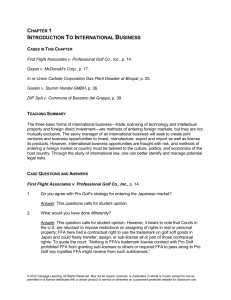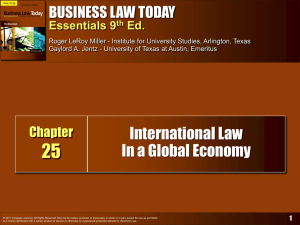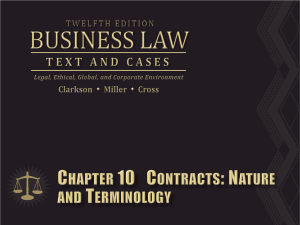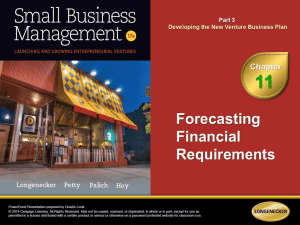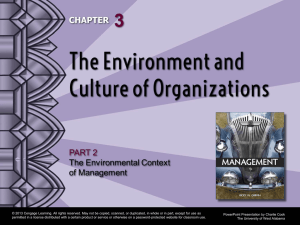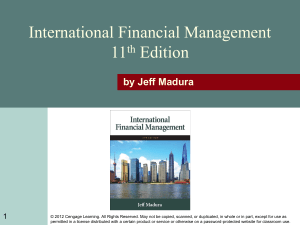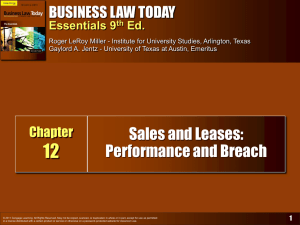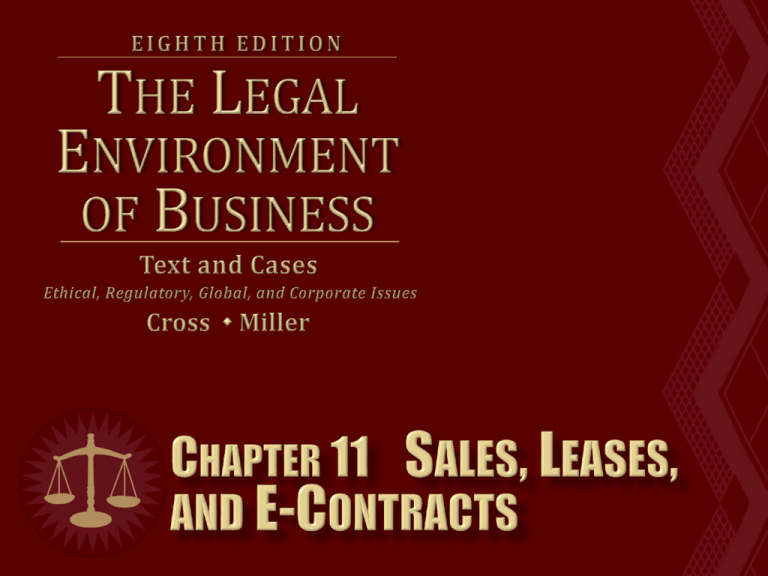
Governs
contracts for sale of
“goods.”
UCC 2 preempts common law
in sale of goods and modifies
common law of contracts in
some areas. But where UCC 2
is silent, common law governs.
© 2012 Cengage Learning. All Rights Reserved. May not be copied, scanned, or duplicated, in whole or in part, except for use as
permitted in a license distributed with a certain product or service or otherwise on a password-protected website for classroom use.
2
Only
applies to goods.
Common law governs real
estate, services or intangible
property.
© 2012 Cengage Learning. All Rights Reserved. May not be copied, scanned, or duplicated, in whole or in part, except for use as
permitted in a license distributed with a certain product or service or otherwise on a password-protected website for classroom use.
3
© 2012 Cengage Learning. All Rights Reserved. May not be copied, scanned, or duplicated, in whole or in part, except for use as
permitted in a license distributed with a certain product or service or otherwise on a password-protected website for classroom use.
4
Article
2 applies to the “sale
of goods.”
A “sale” is the passing of title
from seller to a buyer for a
price (payable in cash, goods,
services).
© 2012 Cengage Learning. All Rights Reserved. May not be copied, scanned, or duplicated, in whole or in part, except for use as
permitted in a license distributed with a certain product or service or otherwise on a password-protected website for classroom use.
5
Article
2 applies to the “sale of
goods.”
A “good” must be tangible and
movable.
Tangible: has physical
Movable: carried from
existence.
place to
place.
© 2012 Cengage Learning. All Rights Reserved. May not be copied, scanned, or duplicated, in whole or in part, except for use as
permitted in a license distributed with a certain product or service or otherwise on a password-protected website for classroom use.
6
Goods
Associated with Real
Estate can fall within Art. 2:
(1)
Contract for sale of minerals
or a structure is a good IF
severance is made by seller. If
severance by buyer, sale is
governed by common law.
(2) Sale of growing crops.
© 2012 Cengage Learning. All Rights Reserved. May not be copied, scanned, or duplicated, in whole or in part, except for use as
permitted in a license distributed with a certain product or service or otherwise on a password-protected website for classroom use.
7
Goods
Associated with Real
Estate can fall within Art. 2:
(3)
Other “things” attached to
real property, capable of being
severed without harm to land.
© 2012 Cengage Learning. All Rights Reserved. May not be copied, scanned, or duplicated, in whole or in part, except for use as
permitted in a license distributed with a certain product or service or otherwise on a password-protected website for classroom use.
8
Mixed
Contracts: Goods and
Services Combined. What law
governs?
“Predominant
Factor” Test – if
goods, then UCC governs, if
services then common law
governs entire contract.
© 2012 Cengage Learning. All Rights Reserved. May not be copied, scanned, or duplicated, in whole or in part, except for use as
permitted in a license distributed with a certain product or service or otherwise on a password-protected website for classroom use.
9
UCC
Art. 2 imposes special
standards upon a “merchant”
who has special business
expertise and is not a casual
buyer/seller.
© 2012 Cengage Learning. All Rights Reserved. May not be copied, scanned, or duplicated, in whole or in part, except for use as
permitted in a license distributed with a certain product or service or otherwise on a password-protected website for classroom use.
10
UCC
Art. 2 defines merchant
as someone who:
Deals
in goods of the kind in the
sale.
Holds herself out as having
special expertise, knowledge, or
skill.
Person who employs a merchant.
© 2012 Cengage Learning. All Rights Reserved. May not be copied, scanned, or duplicated, in whole or in part, except for use as
permitted in a license distributed with a certain product or service or otherwise on a password-protected website for classroom use.
11
Definition
of a Lease
Agreement: contract for lease
of personal goods between a
lessor and a lessee.
Lessor
transfers right to possess
and use goods under lease.
Lessee acquires right to possess
and use goods.
© 2012 Cengage Learning. All Rights Reserved. May not be copied, scanned, or duplicated, in whole or in part, except for use as
permitted in a license distributed with a certain product or service or otherwise on a password-protected website for classroom use.
12
Consumer
Leases: lessor,
lessee who leases for
personal, family, or
household use, and total
payments less than $25,000.
Finance Leases (involves a 3rd
party-supplier).
© 2012 Cengage Learning. All Rights Reserved. May not be copied, scanned, or duplicated, in whole or in part, except for use as
permitted in a license distributed with a certain product or service or otherwise on a password-protected website for classroom use.
13
OFFER:
At common law once a
valid offer is unequivocally
accepted, a binding contract
is formed.
UCC
is more flexible, and allows
for open pricing, payment, and
delivery terms.
© 2012 Cengage Learning. All Rights Reserved. May not be copied, scanned, or duplicated, in whole or in part, except for use as
permitted in a license distributed with a certain product or service or otherwise on a password-protected website for classroom use.
14
UCC
2-204: even if terms of are
undetermined, a contract may
still exist.
Open Terms: “Indefiniteness” is
OK as long as the parties
intended to make a contract and
there is a reasonable basis for a
court to grant a remedy.
© 2012 Cengage Learning. All Rights Reserved. May not be copied, scanned, or duplicated, in whole or in part, except for use as
permitted in a license distributed with a certain product or service or otherwise on a password-protected website for classroom use.
15
Open
Price Term: If parties
have not agreed on pricing, court
can determine “reasonable price
at the time of delivery.”
Open Payment Term: unless
otherwise agreed, payment is due
on delivery (COD).
© 2012 Cengage Learning. All Rights Reserved. May not be copied, scanned, or duplicated, in whole or in part, except for use as
permitted in a license distributed with a certain product or service or otherwise on a password-protected website for classroom use.
16
Open
Delivery Term: Unless
otherwise agreed, buyer takes
delivery at the Seller’s place of
business. UCC2-308(a).
Seller
has duty to make
arrangements in good faith.
© 2012 Cengage Learning. All Rights Reserved. May not be copied, scanned, or duplicated, in whole or in part, except for use as
permitted in a license distributed with a certain product or service or otherwise on a password-protected website for classroom use.
17
Open
Quantity: generally courts
will not impose a quantity and
there is no remedy, unless the
contract is either a requirements
or output contract.
© 2012 Cengage Learning. All Rights Reserved. May not be copied, scanned, or duplicated, in whole or in part, except for use as
permitted in a license distributed with a certain product or service or otherwise on a password-protected website for classroom use.
18
Requirements
Contract:
buyer agrees to purchase
what the buyer needs or
requires.
Output Contract: buyer
agrees to buy all of seller’s
production or output.
© 2012 Cengage Learning. All Rights Reserved. May not be copied, scanned, or duplicated, in whole or in part, except for use as
permitted in a license distributed with a certain product or service or otherwise on a password-protected website for classroom use.
19
Offer
made by merchant in a
signed writing is irrevocable
for reasonable period of time.
No consideration necessary.
The Offer Must be in Writing
and Signed by the Offeror.
© 2012 Cengage Learning. All Rights Reserved. May not be copied, scanned, or duplicated, in whole or in part, except for use as
permitted in a license distributed with a certain product or service or otherwise on a password-protected website for classroom use.
20
Methods
of Acceptance:
offeror can specify a means of
acceptance.
Under
the UCC an offeree can
accept an offer to buy goods
either by a prompt shipment of
conforming or nonconforming
goods.
© 2012 Cengage Learning. All Rights Reserved. May not be copied, scanned, or duplicated, in whole or in part, except for use as
permitted in a license distributed with a certain product or service or otherwise on a password-protected website for classroom use.
21
Shipment
of Non-conforming
Goods: is both an acceptance
and a breach unless goods sent
as an “accommodation” to buyer,
with prompt notice by buyer.
© 2012 Cengage Learning. All Rights Reserved. May not be copied, scanned, or duplicated, in whole or in part, except for use as
permitted in a license distributed with a certain product or service or otherwise on a password-protected website for classroom use.
22
Communication
of
Acceptance.
Additional Terms.
If
One Party is a Merchant:
contract is formed according to
original terms of the offer.
© 2012 Cengage Learning. All Rights Reserved. May not be copied, scanned, or duplicated, in whole or in part, except for use as
permitted in a license distributed with a certain product or service or otherwise on a password-protected website for classroom use.
23
Additional
Terms (cont’d).
When
Both Parties are Merchants,
contract incorporates new terms
unless:
(1) original offer expressly limits
terms, or
(2) material change, or
(3) offeror objects within
reasonable time.
© 2012 Cengage Learning. All Rights Reserved. May not be copied, scanned, or duplicated, in whole or in part, except for use as
permitted in a license distributed with a certain product or service or otherwise on a password-protected website for classroom use.
24
Additional
Terms (cont’d):
Rules
for Striking Additional
Terms:
Contract will consist of terms in
which the parties agree.
Court may strike conflicting or
additional terms.
© 2012 Cengage Learning. All Rights Reserved. May not be copied, scanned, or duplicated, in whole or in part, except for use as
permitted in a license distributed with a certain product or service or otherwise on a password-protected website for classroom use.
25
UCC
adopts common law rule
requiring consideration.
However, modifications do
not need consideration.
Modifications Must be Made
in Good Faith.
© 2012 Cengage Learning. All Rights Reserved. May not be copied, scanned, or duplicated, in whole or in part, except for use as
permitted in a license distributed with a certain product or service or otherwise on a password-protected website for classroom use.
26
When
Modification Without
Consideration Does Require a
Writing.
Merchant
and non-merchant
contracts in which merchant
supplies the forms.
Modifications that trigger Statute
of Fraud issues.
© 2012 Cengage Learning. All Rights Reserved. May not be copied, scanned, or duplicated, in whole or in part, except for use as
permitted in a license distributed with a certain product or service or otherwise on a password-protected website for classroom use.
27
Sale
of goods over $500 must
have a signed writing to be
enforceable.
Sufficiency
of the Writing: signed
by party against whom
enforcement is sought. Normally
not enforceable beyond quantity
of goods shown in the writing.
© 2012 Cengage Learning. All Rights Reserved. May not be copied, scanned, or duplicated, in whole or in part, except for use as
permitted in a license distributed with a certain product or service or otherwise on a password-protected website for classroom use.
28
Special
Rules for Contracts
Between Merchants. After oral
agreement, one of the merchants
sends a signed, written
memorandum containing
essential terms to the other
merchant within a reasonable
time.
© 2012 Cengage Learning. All Rights Reserved. May not be copied, scanned, or duplicated, in whole or in part, except for use as
permitted in a license distributed with a certain product or service or otherwise on a password-protected website for classroom use.
29
Specially
manufactured
goods.
Admissions by breaching
party.
CASE 11.1 Glacial Plains
Cooperative v. Lindgren (2009).
What admission did Lindgren
make?
© 2012 Cengage Learning. All Rights Reserved. May not be copied, scanned, or duplicated, in whole or in part, except for use as
permitted in a license distributed with a certain product or service or otherwise on a password-protected website for classroom use.
30
Partial
Performance: oral
contract is enforceable IF
payment has been made or
goods have been accepted.
© 2012 Cengage Learning. All Rights Reserved. May not be copied, scanned, or duplicated, in whole or in part, except for use as
permitted in a license distributed with a certain product or service or otherwise on a password-protected website for classroom use.
31
© 2012 Cengage Learning. All Rights Reserved. May not be copied, scanned, or duplicated, in whole or in part, except for use as
permitted in a license distributed with a certain product or service or otherwise on a password-protected website for classroom use.
32
Sale
of goods requires different
rules than real property
transactions: risk should not
always pass with title.
UCC replaces title with
identification, risk, and
insurable interest.
© 2012 Cengage Learning. All Rights Reserved. May not be copied, scanned, or duplicated, in whole or in part, except for use as
permitted in a license distributed with a certain product or service or otherwise on a password-protected website for classroom use.
33
For
any interest to pass to
buyer, goods must be
(1)
(2)
in existence and
identified as specific goods in
sales contract.
© 2012 Cengage Learning. All Rights Reserved. May not be copied, scanned, or duplicated, in whole or in part, except for use as
permitted in a license distributed with a certain product or service or otherwise on a password-protected website for classroom use.
34
Occurs when specific goods
are designated as the subject
matter of the contract.
Gives a buyer the right to
obtain insurance on the goods,
and recover from third parties
who damage the good.
© 2012 Cengage Learning. All Rights Reserved. May not be copied, scanned, or duplicated, in whole or in part, except for use as
permitted in a license distributed with a certain product or service or otherwise on a password-protected website for classroom use.
35
Existing Goods: if contact calls
for ascertainable goods in
existence, identification takes
place at the time contract is
made.
© 2012 Cengage Learning. All Rights Reserved. May not be copied, scanned, or duplicated, in whole or in part, except for use as
permitted in a license distributed with a certain product or service or otherwise on a password-protected website for classroom use.
36
Future Goods.
Animals born within 12 months of
contract, identification takes place at
conception.
For crops harvested within 12 months
of contracting, identification takes
place at time of planting (or when crops
begin to grow).
All others, when goods shipped, or
marked or designated by seller.
© 2012 Cengage Learning. All Rights Reserved. May not be copied, scanned, or duplicated, in whole or in part, except for use as
permitted in a license distributed with a certain product or service or otherwise on a password-protected website for classroom use.
37
Contract
between seller and
buyer usually determines
when title passes.
Title can pass:
Upon physical delivery, or
When agreed to by the parties.
© 2012 Cengage Learning. All Rights Reserved. May not be copied, scanned, or duplicated, in whole or in part, except for use as
permitted in a license distributed with a certain product or service or otherwise on a password-protected website for classroom use.
38
If
no agreement, title passes
as follows:
Shipment Contract: title
passes at time and place of
shipment.
Destination Contract: title
passes when goods are
tendered at the destination.
© 2012 Cengage Learning. All Rights Reserved. May not be copied, scanned, or duplicated, in whole or in part, except for use as
permitted in a license distributed with a certain product or service or otherwise on a password-protected website for classroom use.
39
With document of title (bill of
lading): title passes when and
where document delivered.
Without document: title passes
when sales contract is made, if
goods have been identified, or
when identification occurs if they
have not been identified.
© 2012 Cengage Learning. All Rights Reserved. May not be copied, scanned, or duplicated, in whole or in part, except for use as
permitted in a license distributed with a certain product or service or otherwise on a password-protected website for classroom use.
40
ROL
does not necessarily pass
with title. ROL is important
because of insurance concerns.
Unless
agreed otherwise, ROL
passes to Buyer depending on
whether delivery is with or without
movement of the goods.
© 2012 Cengage Learning. All Rights Reserved. May not be copied, scanned, or duplicated, in whole or in part, except for use as
permitted in a license distributed with a certain product or service or otherwise on a password-protected website for classroom use.
41
Shipment
Contracts: Risk of
loss passes to Buyer when goods
tendered to Carrier.
If goods damaged in transit,
Buyer’s bears risk of loss.
© 2012 Cengage Learning. All Rights Reserved. May not be copied, scanned, or duplicated, in whole or in part, except for use as
permitted in a license distributed with a certain product or service or otherwise on a password-protected website for classroom use.
42
Destination
Contracts.
ROL
passes to Buyer when goods
tendered at contractually specified
destination.
Whether
a contract is
shipment or destination has
significant consequences to all
parties.
© 2012 Cengage Learning. All Rights Reserved. May not be copied, scanned, or duplicated, in whole or in part, except for use as
permitted in a license distributed with a certain product or service or otherwise on a password-protected website for classroom use.
43
Often
goods are held by a
bailee on behalf of the seller
in a bailment arrangement.
Documents
of title give bailee
possession of goods and/or
contracts to deliver them.
Examples: warehouse, trucking
company.
© 2012 Cengage Learning. All Rights Reserved. May not be copied, scanned, or duplicated, in whole or in part, except for use as
permitted in a license distributed with a certain product or service or otherwise on a password-protected website for classroom use.
44
Goods Held by Seller:
Document of Title is generally
not used.
If Seller is a merchant, risk of
loss passes when buyer takes
physical possession of goods.
(ROL remains with seller until
buyer takes physical possession.)
© 2012 Cengage Learning. All Rights Reserved. May not be copied, scanned, or duplicated, in whole or in part, except for use as
permitted in a license distributed with a certain product or service or otherwise on a password-protected website for classroom use.
45
Goods
Held by a Bailee
(Warehouse). Risk of loss
passes to buyer when:
Buyer
receives document of title;
bailee acknowledges Buyer’s right
to goods and buyer receives title
and has reasonable time to pick
up.
© 2012 Cengage Learning. All Rights Reserved. May not be copied, scanned, or duplicated, in whole or in part, except for use as
permitted in a license distributed with a certain product or service or otherwise on a password-protected website for classroom use.
46
© 2012 Cengage Learning. All Rights Reserved. May not be copied, scanned, or duplicated, in whole or in part, except for use as
permitted in a license distributed with a certain product or service or otherwise on a password-protected website for classroom use.
47
Generally
breaching party
bears risk of loss.
If seller delivers nonconforming goods, ROL stays
with seller.
ROL
does not pass to buyer until
seller “cures” defect, or buyer
accepts goods in spite of defect.
© 2012 Cengage Learning. All Rights Reserved. May not be copied, scanned, or duplicated, in whole or in part, except for use as
permitted in a license distributed with a certain product or service or otherwise on a password-protected website for classroom use.
48
ROL
immediately shifts to
buyer, with limitations:
Seller
must identify the goods.
ROL passes to buyer for a
commercially reasonable amount of
time after seller learns of breach.
Buyer only liable to extent that
seller’s insurance does not cover
loss.
© 2012 Cengage Learning. All Rights Reserved. May not be copied, scanned, or duplicated, in whole or in part, except for use as
permitted in a license distributed with a certain product or service or otherwise on a password-protected website for classroom use.
49
Buyer
has an insurable interest
in identified goods.
Seller has an insurable interest
as long as she retains title or a
security interest in goods.
Both
buyers and sellers can have
an insurable interest at the same
time.
© 2012 Cengage Learning. All Rights Reserved. May not be copied, scanned, or duplicated, in whole or in part, except for use as
permitted in a license distributed with a certain product or service or otherwise on a password-protected website for classroom use.
50
Mutual
Duties:
Seller
must transfer and deliver
conforming goods.
Buyer must accept and pay for
conforming goods.
In the absence of an agreement
between Seller and Buyer, UCC
Article 2 controls as set out
below.
© 2012 Cengage Learning. All Rights Reserved. May not be copied, scanned, or duplicated, in whole or in part, except for use as
permitted in a license distributed with a certain product or service or otherwise on a password-protected website for classroom use.
51
Good
faith means honesty in
fact.
For a merchant, it means honesty in
fact and observance of reasonable
commercial standards of fair
dealing in the trade.
Merchants are held to a higher
standard of care than nonmerchants.
© 2012 Cengage Learning. All Rights Reserved. May not be copied, scanned, or duplicated, in whole or in part, except for use as
permitted in a license distributed with a certain product or service or otherwise on a password-protected website for classroom use.
52
Tender
of Delivery: occurs
when seller delivers
conforming goods to buyer.
Requires reasonable notice.
Reasonable hour and manner.
Generally, all goods in one
installment (unless agreed upon
by parties).
© 2012 Cengage Learning. All Rights Reserved. May not be copied, scanned, or duplicated, in whole or in part, except for use as
permitted in a license distributed with a certain product or service or otherwise on a password-protected website for classroom use.
53
Place
of Delivery: parties can
agree goods tendered at a
particular destination for
buyer to take possession.
If
the contract does not specify,
then it is the seller’s place of
business (or the location of the
goods.)
© 2012 Cengage Learning. All Rights Reserved. May not be copied, scanned, or duplicated, in whole or in part, except for use as
permitted in a license distributed with a certain product or service or otherwise on a password-protected website for classroom use.
54
If
goods, or tender of
delivery, fail in any respect to
conform to the contract, the
Buyer has the right to:
Accept the goods;
Reject the entire shipment; or
Accept part and reject part.
© 2012 Cengage Learning. All Rights Reserved. May not be copied, scanned, or duplicated, in whole or in part, except for use as
permitted in a license distributed with a certain product or service or otherwise on a password-protected website for classroom use.
55
Agreement
of the Parties:
agree that some defective goods
will be acceptable.
Cure: seller has right to repair
or replace defective goods within
the time of contract
performance.
© 2012 Cengage Learning. All Rights Reserved. May not be copied, scanned, or duplicated, in whole or in part, except for use as
permitted in a license distributed with a certain product or service or otherwise on a password-protected website for classroom use.
56
Cure
(cont’d).
Substantially
restricts right of
rejection; buyers must act in
good faith and give specific
reasons for refusing
acceptance.
© 2012 Cengage Learning. All Rights Reserved. May not be copied, scanned, or duplicated, in whole or in part, except for use as
permitted in a license distributed with a certain product or service or otherwise on a password-protected website for classroom use.
57
Substitution
of Carriers. If a
carrier becomes impracticable or
unavailable through no fault of
either party, a commercially
reasonable substitute is
acceptable.
© 2012 Cengage Learning. All Rights Reserved. May not be copied, scanned, or duplicated, in whole or in part, except for use as
permitted in a license distributed with a certain product or service or otherwise on a password-protected website for classroom use.
58
Commercial
Impracticability.
If
unforeseeable event occurs, the
perfect tender rule no longer
applies.
Seller must notify the buyer as
soon as practicable the shipment
is delayed or undeliverable.
© 2012 Cengage Learning. All Rights Reserved. May not be copied, scanned, or duplicated, in whole or in part, except for use as
permitted in a license distributed with a certain product or service or otherwise on a password-protected website for classroom use.
59
Destruction
of Identified
Goods.
If
no fault of either party and it
occurs,
Before risk passes to Buyer then,
Both Seller and Buyer are excused
from performance.
© 2012 Cengage Learning. All Rights Reserved. May not be copied, scanned, or duplicated, in whole or in part, except for use as
permitted in a license distributed with a certain product or service or otherwise on a password-protected website for classroom use.
60
Assurance
and Cooperation.
One
party has “reasonable
grounds” to believe other party
will not perform, she can ask for
written assurance, or ‘suspend’
performance or delivery.
Failure to respond may constitute
a repudiation of the contract.
© 2012 Cengage Learning. All Rights Reserved. May not be copied, scanned, or duplicated, in whole or in part, except for use as
permitted in a license distributed with a certain product or service or otherwise on a password-protected website for classroom use.
61
Payment:
make payment at
the time and place the Buyer
receives the goods.
Credit has to be prearranged.
Pay with cash, credit card, check.
© 2012 Cengage Learning. All Rights Reserved. May not be copied, scanned, or duplicated, in whole or in part, except for use as
permitted in a license distributed with a certain product or service or otherwise on a password-protected website for classroom use.
62
Right
of Inspection. Buyer has
absolute right to inspection
before payment, unless C.O.D.
CASE
11.2 Romero v. ScogginsDickey Chevrolet-Buick, Inc.
(2010). Why wasn’t the ‘contract
order’ a binding contract for sale
of goods?
© 2012 Cengage Learning. All Rights Reserved. May not be copied, scanned, or duplicated, in whole or in part, except for use as
permitted in a license distributed with a certain product or service or otherwise on a password-protected website for classroom use.
63
Acceptance. Buyer can accept
goods:
By words or conduct.
If Buyer had reasonable
amount
of time and failed to reject.
Buyer performs an act which
indicates he thinks he is the
owner.
© 2012 Cengage Learning. All Rights Reserved. May not be copied, scanned, or duplicated, in whole or in part, except for use as
permitted in a license distributed with a certain product or service or otherwise on a password-protected website for classroom use.
64
Partial Acceptance.
If
some of the goods do not
conform to the contract, and
seller has failed to cure, buyer
can make a partial acceptance.
But buyer cannot accept less a
single commercial unit.
© 2012 Cengage Learning. All Rights Reserved. May not be copied, scanned, or duplicated, in whole or in part, except for use as
permitted in a license distributed with a certain product or service or otherwise on a password-protected website for classroom use.
65
A
party communicates
intention to not perform.
Constitutes breach of contract.
Nonbreaching party may suspend
performance and treat the AR as
material breach and pursue a
remedy; or wait a reasonable
time.
© 2012 Cengage Learning. All Rights Reserved. May not be copied, scanned, or duplicated, in whole or in part, except for use as
permitted in a license distributed with a certain product or service or otherwise on a password-protected website for classroom use.
66
A
Repudiation May Be
Retracted.
Breaching
party may ‘retract’
repudiation by any method that
clearly indicates their intent.
However, no retraction if the
nonbreaching party has
materially changed their position.
© 2012 Cengage Learning. All Rights Reserved. May not be copied, scanned, or duplicated, in whole or in part, except for use as
permitted in a license distributed with a certain product or service or otherwise on a password-protected website for classroom use.
67
Remedies
of the Seller or
Lessor.
When
buyer breaches, seller has
various UCC remedies, depending
on circumstances:
Who has possession of the goods?
Are goods in transit?
Has buyer rejected or accepted the
goods?
© 2012 Cengage Learning. All Rights Reserved. May not be copied, scanned, or duplicated, in whole or in part, except for use as
permitted in a license distributed with a certain product or service or otherwise on a password-protected website for classroom use.
68
When
Goods in Possession of
the Seller:
Right
to Cancel (Rescind) the
Contract.
Seller must notify buyer.
Buyer is not discharged from
remaining obligations.
© 2012 Cengage Learning. All Rights Reserved. May not be copied, scanned, or duplicated, in whole or in part, except for use as
permitted in a license distributed with a certain product or service or otherwise on a password-protected website for classroom use.
69
Goods
Right
in Possession of Seller.
to Withhold Delivery.
If material breach by buyer, seller
can withhold delivery of all goods.
If non-material breach, seller can
withhold delivery of this
installment.
© 2012 Cengage Learning. All Rights Reserved. May not be copied, scanned, or duplicated, in whole or in part, except for use as
permitted in a license distributed with a certain product or service or otherwise on a password-protected website for classroom use.
70
Goods
in Possession of Seller.
Right
to Resell or Dispose of
Goods.
Seller can resell and keep profits from
sale and hold buyer liable for
difference.
Seller must give buyer notice of sale,
unless goods are perishable.
© 2012 Cengage Learning. All Rights Reserved. May not be copied, scanned, or duplicated, in whole or in part, except for use as
permitted in a license distributed with a certain product or service or otherwise on a password-protected website for classroom use.
71
Goods
in Possession of Seller.
Right
to Recover Purchase Price
or Lease Payments Due.
Seller can bring action to recover
purchase price or lease payments.
If seller must sue, he must hold
goods for buyer, and sell anytime
before collecting the judgment.
© 2012 Cengage Learning. All Rights Reserved. May not be copied, scanned, or duplicated, in whole or in part, except for use as
permitted in a license distributed with a certain product or service or otherwise on a password-protected website for classroom use.
72
Goods
in Possession of Seller.
Right
to Recover Damages for
Buyer’s Nonacceptance.
If buyer repudiates or wrongfully
chooses to accept goods, seller
can bring action to recover
damages.
Damages: market price at the time
& place of tender + incidentals.
© 2012 Cengage Learning. All Rights Reserved. May not be copied, scanned, or duplicated, in whole or in part, except for use as
permitted in a license distributed with a certain product or service or otherwise on a password-protected website for classroom use.
73
Goods
are “in transit” when
Seller has tendered goods to
Carrier.
Seller can stop goods in
transit if:
Buyer
Buyer
is insolvent.
is in breach.
© 2012 Cengage Learning. All Rights Reserved. May not be copied, scanned, or duplicated, in whole or in part, except for use as
permitted in a license distributed with a certain product or service or otherwise on a password-protected website for classroom use.
74
Seller
may sue for the
purchase price.
Seller
may also sue Buyer if goods
were “specially-made” which
Seller cannot resell.
Seller may also sue for the
purchase price if the goods were
destroyed and the risk had
already passed to the Buyer.
© 2012 Cengage Learning. All Rights Reserved. May not be copied, scanned, or duplicated, in whole or in part, except for use as
permitted in a license distributed with a certain product or service or otherwise on a password-protected website for classroom use.
75
When
Seller or Lessor
Refuses to Deliver the Goods.
Buyer
has the right to:
Cancel (rescind) the contract.
Recover Goods paid for if seller
insolvent: whether partial or full
payment.
© 2012 Cengage Learning. All Rights Reserved. May not be copied, scanned, or duplicated, in whole or in part, except for use as
permitted in a license distributed with a certain product or service or otherwise on a password-protected website for classroom use.
76
When
Seller or Lessor
Refuses to Deliver the Goods.
Buyer
has the right to :
Sue for specific performance and
recover damages.
Cover: in some situations.
Replevy goods.
Sue to Recover Damages.
© 2012 Cengage Learning. All Rights Reserved. May not be copied, scanned, or duplicated, in whole or in part, except for use as
permitted in a license distributed with a certain product or service or otherwise on a password-protected website for classroom use.
77
Right
to Reject Goods.
Buyer
must timely notify seller of
rejection and reasons and follow
seller’s directions.
Merchant-buyer has good faith
obligation to follow reasonable
instructions.
© 2012 Cengage Learning. All Rights Reserved. May not be copied, scanned, or duplicated, in whole or in part, except for use as
permitted in a license distributed with a certain product or service or otherwise on a password-protected website for classroom use.
78
Revocation
of Acceptance for
substantial nonconformity,
and:
Acceptance
assumed defect would
be cured, or
Nonconformity was discovered
after acceptance.
Effective upon notice to seller.
© 2012 Cengage Learning. All Rights Reserved. May not be copied, scanned, or duplicated, in whole or in part, except for use as
permitted in a license distributed with a certain product or service or otherwise on a password-protected website for classroom use.
79
Right
to Recover Damages for
Accepted Goods.
Buyer
may keep the goods and
recover any loss in ordinary
course of events.
Measure of damages: difference
between value of accepted goods
and goods as warranted.
© 2012 Cengage Learning. All Rights Reserved. May not be copied, scanned, or duplicated, in whole or in part, except for use as
permitted in a license distributed with a certain product or service or otherwise on a password-protected website for classroom use.
80
Exclusive
Remedies.
Consequential Damages.
Lemon Laws.
© 2012 Cengage Learning. All Rights Reserved. May not be copied, scanned, or duplicated, in whole or in part, except for use as
permitted in a license distributed with a certain product or service or otherwise on a password-protected website for classroom use.
81
A
warranty is an assurance or
guarantee by the seller of
certain facts concerning the
goods being sold or leased.
If seller breaches a warranty,
buyer can recover damages, or
rescind the contract.
© 2012 Cengage Learning. All Rights Reserved. May not be copied, scanned, or duplicated, in whole or in part, except for use as
permitted in a license distributed with a certain product or service or otherwise on a password-protected website for classroom use.
82
Warranties
automatically arise
in most commercial sales
transactions.
Normally warranties can be
disclaimed or modified with
specific language in the
contract.
© 2012 Cengage Learning. All Rights Reserved. May not be copied, scanned, or duplicated, in whole or in part, except for use as
permitted in a license distributed with a certain product or service or otherwise on a password-protected website for classroom use.
83
Under
the UCC, three types of
warranties arise in sales and
lease contracts:
Good Title.
No Liens.
No Infringements.
© 2012 Cengage Learning. All Rights Reserved. May not be copied, scanned, or duplicated, in whole or in part, except for use as
permitted in a license distributed with a certain product or service or otherwise on a password-protected website for classroom use.
84
Seller
can create warranty by
making representations about
quality, condition, or
performance of good.
Can
be created by:
Any Affirmation or Promise.
Any Description.
Any Sample or Model.
© 2012 Cengage Learning. All Rights Reserved. May not be copied, scanned, or duplicated, in whole or in part, except for use as
permitted in a license distributed with a certain product or service or otherwise on a password-protected website for classroom use.
85
Seller
does not have to use
the words “guarantee” or
“warranty.”
Reasonable buyer must only
believe warranty was ‘basis of
the bargain.’
Buyer
must rely on warranty
when he enters into contract.
© 2012 Cengage Learning. All Rights Reserved. May not be copied, scanned, or duplicated, in whole or in part, except for use as
permitted in a license distributed with a certain product or service or otherwise on a password-protected website for classroom use.
86
Statements
of Opinion and
Value.
Only
statements of fact create
express warranties.
Exception for Statements of
Opinion by Experts.
Puffery versus Express
Warranties.
© 2012 Cengage Learning. All Rights Reserved. May not be copied, scanned, or duplicated, in whole or in part, except for use as
permitted in a license distributed with a certain product or service or otherwise on a password-protected website for classroom use.
87
Inferred
at law based on the
circumstances or nature of
the transaction.
© 2012 Cengage Learning. All Rights Reserved. May not be copied, scanned, or duplicated, in whole or in part, except for use as
permitted in a license distributed with a certain product or service or otherwise on a password-protected website for classroom use.
88
Automatically
arises from sale
of goods by merchants.
Merchantable
Goods:
“Reasonably fit for ordinary
purposes for which such goods are
sold.”
Conform to promises on label.
Adequately packaged and labeled.
© 2012 Cengage Learning. All Rights Reserved. May not be copied, scanned, or duplicated, in whole or in part, except for use as
permitted in a license distributed with a certain product or service or otherwise on a password-protected website for classroom use.
89
Merchantable
Food.
Fit
to eat based on consumer
expectations.
CASE 11.3 Webster v. Blue Ship
Tea Room, Inc. (1964). Was the
soup fit to eat on the basis of
consumer expectations?
© 2012 Cengage Learning. All Rights Reserved. May not be copied, scanned, or duplicated, in whole or in part, except for use as
permitted in a license distributed with a certain product or service or otherwise on a password-protected website for classroom use.
90
Arises
by any seller who:
Knows
the particular purpose for
which the goods are being
bought; and
Knows the buyer is relying on
seller’s skill and judgment to
select suitable goods.
© 2012 Cengage Learning. All Rights Reserved. May not be copied, scanned, or duplicated, in whole or in part, except for use as
permitted in a license distributed with a certain product or service or otherwise on a password-protected website for classroom use.
91
Ordinary vs. Particular Purpose:
Goods can be merchantable but
unfit for a particular purpose.
Knowledge and Reliance
Requirements: seller must have
reason to know purpose, and
buyer must have relied on the
recommendation.
© 2012 Cengage Learning. All Rights Reserved. May not be copied, scanned, or duplicated, in whole or in part, except for use as
permitted in a license distributed with a certain product or service or otherwise on a password-protected website for classroom use.
92
Arises
when both parties to a
contract have knowledge of a
well-recognized trade custom.
Courts infer that both meant
this custom to apply to their
transaction.
© 2012 Cengage Learning. All Rights Reserved. May not be copied, scanned, or duplicated, in whole or in part, except for use as
permitted in a license distributed with a certain product or service or otherwise on a password-protected website for classroom use.
93
Online
Offers.
Displaying
the Offer. Seller’s
website should include
hyperlink to page with full
contract.
Provisions to Include.
© 2012 Cengage Learning. All Rights Reserved. May not be copied, scanned, or duplicated, in whole or in part, except for use as
permitted in a license distributed with a certain product or service or otherwise on a password-protected website for classroom use.
94
Provisions to Include:
Acceptance of Terms: what
constitutes an acceptance.
Payment: how payment is made.
Return Policy.
Disclaimer: of liability for certain
uses of the goods.
Limitations on Remedies: if goods
defective or contract is breached.
© 2012 Cengage Learning. All Rights Reserved. May not be copied, scanned, or duplicated, in whole or in part, except for use as
permitted in a license distributed with a certain product or service or otherwise on a password-protected website for classroom use.
95
Provisions to Include:
Privacy Policy.
Dispute Resolution: usually
arbitration or forum-selection
clauses.
Choice-of-law clause.
© 2012 Cengage Learning. All Rights Reserved. May not be copied, scanned, or duplicated, in whole or in part, except for use as
permitted in a license distributed with a certain product or service or otherwise on a password-protected website for classroom use.
96
Click-On
Agreements.
Courts
have concluded a binding
contract can be formed by
clicking on a box indicating “I
Accept” or “I Agree.” Contract
can be formed via website or
software.
Law does not require parties read
all the terms.
© 2012 Cengage Learning. All Rights Reserved. May not be copied, scanned, or duplicated, in whole or in part, except for use as
permitted in a license distributed with a certain product or service or otherwise on a password-protected website for classroom use.
97
Shrink-Wrap
Contract
Agreements.
terms are inside the
box.
Party opening box agrees to
terms by keeping merchandise.
Enforceable vs. Unenforceable
Terms.
© 2012 Cengage Learning. All Rights Reserved. May not be copied, scanned, or duplicated, in whole or in part, except for use as
permitted in a license distributed with a certain product or service or otherwise on a password-protected website for classroom use.
98
Browse-Wrap
Terms.
Like
click-on agreements,
browse-wrap terms can occur in
transactions over internet.
Unlike click-on agreements,
browse-wrap terms do not
require assent and are usually
unenforceable.
© 2012 Cengage Learning. All Rights Reserved. May not be copied, scanned, or duplicated, in whole or in part, except for use as
permitted in a license distributed with a certain product or service or otherwise on a password-protected website for classroom use.
99
E-Signature: electronic sound,
symbol, or process attached to or
logically associated with a record
and executed or adopted by a
person with the intent to sign the
record.
Digitized Signature: graphical
image of a handwritten signature.
© 2012 Cengage Learning. All Rights Reserved. May not be copied, scanned, or duplicated, in whole or in part, except for use as
permitted in a license distributed with a certain product or service or otherwise on a password-protected website for classroom use.
100
E-SIGN
(2000) gives esignatures and e-documents
legal force.
For
an e-signature to be
enforceable, the contracting
parties must have agreed to use
electronic signatures.
© 2012 Cengage Learning. All Rights Reserved. May not be copied, scanned, or duplicated, in whole or in part, except for use as
permitted in a license distributed with a certain product or service or otherwise on a password-protected website for classroom use.
101
Applicability
of the CISG.
Comparison of CISG and UCC.
Mirror Image Rule.
Irrevocable Offers.
Statute of Frauds.
Necessity of a Price Term.
Time of Contract Formation.
© 2012 Cengage Learning. All Rights Reserved. May not be copied, scanned, or duplicated, in whole or in part, except for use as
permitted in a license distributed with a certain product or service or otherwise on a password-protected website for classroom use.
102
Remedies
for Breach of
International Sales Contracts.
CISG
provides remedies similar to
the UCC.
Article 74 provides for money
damages, foreseeable consequential
damages.
© 2012 Cengage Learning. All Rights Reserved. May not be copied, scanned, or duplicated, in whole or in part, except for use as
permitted in a license distributed with a certain product or service or otherwise on a password-protected website for classroom use.
103
Remedies (continued).
Damages are difference between
contract price and market price.
Article 28 provides for specific
performance where a country
would normally grant it in their
own law.
Parties can agree to what law they
will use.
© 2012 Cengage Learning. All Rights Reserved. May not be copied, scanned, or duplicated, in whole or in part, except for use as
permitted in a license distributed with a certain product or service or otherwise on a password-protected website for classroom use.
104



